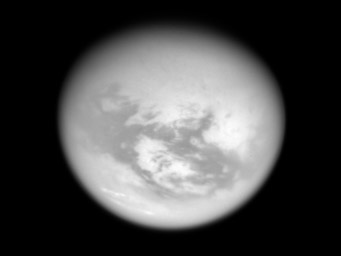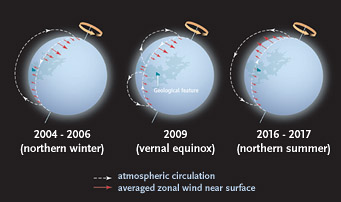Among the most anticipated results from NASA's Cassini mission was a chance to reveal the surface of Titan, Saturn's largest moon and arguably the most fascinating solid body in the solar system (besides Earth, of course).

To human eyes the haze in Titan's atmosphere would completely hide its surface. But NASA's Cassini orbiter can glimpse the surface by taking images through near-infrared filters, as it did here in May 2007. Note the wispy clouds near the bottom of the disk. At radar wavelengths the atmosphere is completely transparent.
NASA / JPL / Space Science Inst.
Cassini's first good chance to peer through Titan's murky atmosphere using radar came in October 2004. Those initial radar images revealed a world brimming with geologic diversity:
But something strange came to light later on, after some of the same areas were viewed again on subsequent close passes: Titan's features weren't quite where they were supposed to be. In some cases they were nearly 20 miles (30 km) from their predicted locations.
Because Saturn has such a powerful gravitational grip on its moons, the mission team had assumed that Titan's spin axis is exactly perpendicular to its orbital plane and that the big moon rotates synchronously, completing exactly one rotation every time it goes around Saturn (15.945 days). But the radar data are telling a different story: Titan's spin axis has to be tipped slightly, just 0.3°, and its rotation needs to be ever-so-slightly faster than expected, by just 0.004%. Moreover, this slight rotational mismatch seems to be increasing — Titan is speeding up!
(It's amazing to me that the radar maps and spacecraft tracking are precise enough to see these discrepancies. But they're really real!)

If a subsurface ocean lies between Titan's crust and its deep interior, then winds in the dense atmosphere might be forcing the moon to spin slightly faster during northern winter (left) and to slow down during northern summer (right). Click on the image for a larger view.
Christophe Sotin / Gabriel Tobie / Science magazine
One explanation might be that winds in Titan's massive atmosphere, which is much denser than Earth's, are slowly influencing the moon's rotation. Ordinarily this effect would be inconsequentially tiny. (For example, persistent seasonal winds in Earth's atmosphere change the length of our day by no more than a millisecond per year.)
But several years ago theorists surmised that Titan probably isn't solid throughout. Instead, they argue, this Mercury-size moon has a global layer of ammonia-infused water just below its water-ice crust. A global ocean would effectively decouple the crust from rotation of the deeper interior, allowing the outer shell to spin at its own rate and making it much more susceptible to external forces like surface winds.
In tomorrow's issue of Science, Ralph Lorenz (Applied Physics Laboratory) and eight others argue that an internal ocean is the best way to make sense of Titan's rotational quirks. "The bottom line," Lorenz told me via e-mail, is that "the rotation is changing, and the only way it could be changing is if the crust is decoupled."
Right now it's late winter in Titan's northern hemisphere, and the leading circulation model predicts that near-surface winds should be causing the spin to accelerate. That's what Cassini has observed. In a few years, once northern summer arrives, the spin rate should slow. Cassini should be able to track this reversal if can hold out until, say, 2011.
However, the model and Cassini's observations don't match exactly. Specifically, Titan seems to be about two years behind its predicted speed-up schedule. Perhaps the model needs tweaking, or other forces (such as Saturn's pull on a bulge in Titan's midsection) might be involved. Conceivably Titan's spin axis is wobbling, as has been suggested by French dynamicist Benoît Noyelles. It's even possible that Titan was spun up by a large impact in the recent past. But a strike that potent should only occur every 100 million years — and it would have punched a hole in the ice at least 100 km across!
 1
1
Comments
Brian Breshears
March 21, 2008 at 10:40 am
I'm fairly amazed at the rate of discovery of new features and odd phenomenon in astronomy these days - Cassini is an example of why space exploration is so important to our understanding of the universe. Cassini is a strong argument for continued robotic exploration rather than manned – so much more can be gained from the same investment.
The unusual spin of Titan got me to thinking - what exactly does 'spin' mean when discussing a planetary body? If Titan's frozen ice shell is decoupled from its interior, do the movements of the ice shell rotation qualify as spin? It seems to me that this could blur the line between what might be considered as 'atmosphere' for a planetary body. We consider gas around a planet as separate from the planet itself when we define the spin of a planet (although I suppose the larger planets we average the apparent movement of the observable gas to derive spin). If we were so lucky as to find a planetary body that is completely covered in a liquid that displays currents and movement properties that are constantly changing, how would we define the its spin? So how is the spin rate of a planetary body defined? If Titan has another surface under the ice that is, I suppose, rock, then is that what is used to define spin? What about planetary bodies that possess a magnetosphere (Titan has no intrinsic magnetosphere – I don’t know what effect its induced magnetosphere might have) that could indicate a less than solid core for a planetary body (again, not Titan) – if that core rotates at less than or more than the rock crust how does that figure in defining the spin? I’m guessing that the most likely answer to these questions is that the spin of a planetary body is described as the rate at which mass of the planetary body rotates around an axis. If the shell of Titan is decoupled and is constantly changing its rotational properties does this leave Titan with a variable spin rate? It seems it would also imply a variable axis of spin.
You must be logged in to post a comment.
You must be logged in to post a comment.